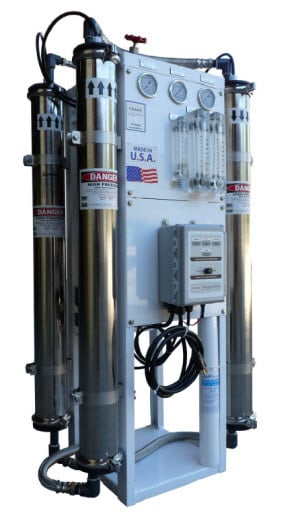Will Reverse Osmosis Membranes Remove Odor from Well Water?
A homeowner asked us if their new whole-house reverse osmosis system should be removing odors from their well water. This commercial system had no carbon filters, just pre-filters and the RO system (not supplied by us).
Many homeowners use under-sink reverse osmosis systems, which have carbon filters as part of the system, and those filters remove odor. It may be misleading for some to think that the RO membrane is removing the odors, but the carbon filter is causing the odor.
If an odor exists, you should remove it before installing under-sink or whole-house RO systems. This helps ensure the best results and prevents fouling caused by osmotic pressure and the natural flow of gases through the membrane.
Although H₂S can pass through the membrane as a gas and be removed afterward, it’s best to eliminate it before the RO system.
Often, the odor is a result of a dissolved gas, and gasses pass through the RO membrane.If untreated, hydrogen sulfide odors in well water can cause slime and buildup on RO membranes, especially when hydrogen sulfide oxidizes or sulfur bacteria are present.
RO systems can remove odors if they include an oxidation filter, carbon filter, aeration, or another component that can remove odor. RO membranes do not remove odor by themselves.
We recommended to this customer that they add a Duke Aeration System to remove the sulfur odors prior to the system and this solved the problem.
Introduction
Reverse osmosis (RO) is a water purification process that uses a semipermeable membrane to remove impurities from water. It is a popular method for producing clean drinking water and is widely used in various industries, including residential, commercial, and industrial applications. This article will provide an overview of the reverse osmosis process, its components, and how it works.

Definition and Process of Reverse Osmosis
Reverse osmosis is a pressure-driven separation process that uses a semi-permeable membrane to remove impurities from water. The process involves applying pressure to the feedwater, which forces the water through the membrane, resulting in a purified product called permeate. The semipermeable membrane used in RO is typically made of a thin-film composite material, such as polyamide. The membrane has tiny pores that allow water molecules to pass through but block larger particles and impurities.
Overview of RO System Components
A reverse osmosis system typically consists of several components, including:
- A high-pressure pump: This pump applies pressure to the feedwater, forcing it through the semi-permeable membrane.
- A semi-permeable membrane: This membrane is the heart of the RO system and removes impurities from the water.
- A pressure vessel: This vessel houses the semi-permeable membrane and provides a safe and efficient way to apply pressure to the feedwater.
- The RO system produces a concentrate flow, which carries the impurities removed from the feedwater.
- A purified water stream: This is clean drinking water produced by the RO system and free from impurities.
The RO system applies pressure to the feedwater, forcing it through the semi-permeable membrane. The membrane removes impurities from the water and collects the purified water in a separate stream. The system typically discharges the concentrate flow, which contains the impurities, to a drain or wastewater treatment system.
Types of Reverse Osmosis Membranes
Reverse osmosis (RO) membranes are the heart of any RO system, responsible for filtering out impurities and producing clean water. There are several types of RO membranes, each with unique characteristics suited to different applications:
- Thin-Film Composite (TFC) Membranes: The most commonly used type of reverse osmosis (RO) membrane. Manufacturers create them from a thin layer of polyamide or polyvinylidene fluoride (PVDF) supported by a thicker, porous layer of polyester or polypropylene. TFC membranes offer high rejection rates and strong durability. They are highly effective in removing a wide range of contaminants, making them ideal for residential and commercial use.
- Cellulose Triacetate (CTA) Membranes: CTA membranes are made from cellulose acetate and are particularly resistant to chlorine, which can degrade other types of membranes. While they offer high rejection rates, they are less durable than TFC membranes and may require more frequent replacement. They are often used in applications where chlorine resistance is a priority.
- Polyamide Membranes: These membranes are crafted from polyamide and are known for their high rejection rates and resistance to fouling. They are commonly used in industrial applications where high-purity water is essential. Their robust nature makes them suitable for challenging water conditions.
- Ceramic Membranes: Made from ceramic materials, these membranes are highly resistant to fouling and can withstand harsh operating conditions. They are often used in industrial settings where high purity and durability are required. Ceramic membranes are also known for their long lifespan and ability to handle high temperatures.
Choosing the right type of RO membrane depends on the specific application, the quality of the feedwater, and the desired level of purification. By selecting the appropriate membrane, RO systems can effectively remove impurities and produce high-quality drinking water.
Importance of Pre-Treatment in Reverse Osmosis
Pre-treatment is a critical step in the reverse osmosis (RO) process, ensuring the system's longevity and efficiency. It involves removing impurities from the feedwater before they enter the RO system, which helps prevent fouling and damage to the membrane.
RO System Maintenance and Cleaning
Regular maintenance and cleaning are essential to ensure the optimal performance and longevity of reverse osmosis (RO) systems. Proper care of the RO membranes is particularly important, as they are the key component responsible for water purification.
RO Membrane Cleaning and Replacement
RO membranes require regular cleaning and replacement to maintain their effectiveness. Over time, impurities and scales can accumulate on the membrane surface, reducing its ability to filter water. Regular cleaning helps remove these contaminants and restore the membrane’s performance.














